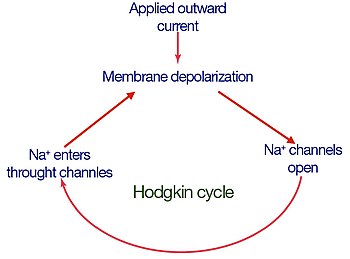
In membrane biology, the Hodgkin cycle is a key component of membrane physiology that describes bioelectrical impulses, especially prevalent in neural and muscle tissues. It was identified by British physiologist and biophysicist Sir Alan Lloyd Hodgkin.[1]
The Hodgkin cycle represents a positive feedback loop in which an initial membrane depolarization leads to uncontrolled deflection of the membrane potential to near VNa. The initial depolarization must reach or surpass a certain threshold in order to activate voltage-gated Na+ channels. The opening of Na+ channels allows Na+ inflow, which, in turn, further depolarizes the membrane. Additional depolarization activates additional Na+ channels. This cycle leads to a very rapid rise in Na+ conductance (gNa), which moves the membrane potential close to VNa. The cycle is broken when the membrane potential reaches to the sodium equilibrium potential and potassium channels open to re-polarize the membrane potential. This positive feedback loop means that the closer these voltage-gated Na+ channels are to each other, the lower the threshold of activation.[1]